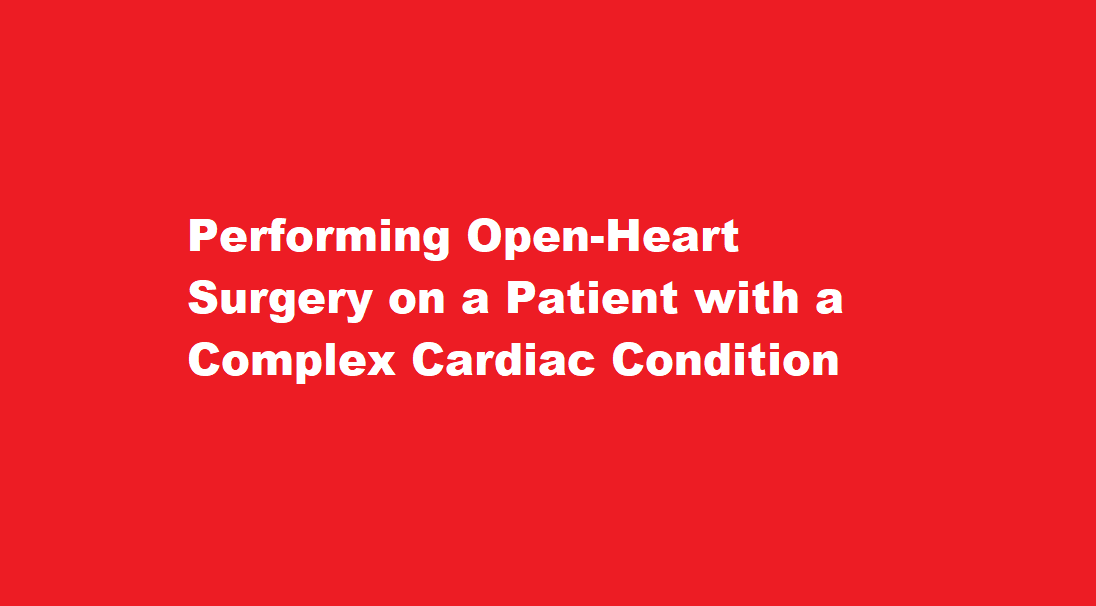Performing Open-Heart Surgery on a Patient with a Complex Cardiac Condition


Introduction
Open-heart surgery, also known as cardiac surgery, is a complex and delicate procedure that involves repairing or replacing damaged heart valves, arteries, or other structures within the heart. When dealing with patients who have complex cardiac conditions, such as congenital heart defects or advanced coronary artery disease, the surgical team must exercise the utmost precision and skill. In this article, we will explore the steps and considerations involved in performing open-heart surgery on a patient with a complex cardiac condition.
Preoperative Planning
Comprehensive Evaluation
Before any surgical procedure, a thorough evaluation of the patient’s medical history, physical condition, and diagnostic tests is essential. For complex cardiac cases, this evaluation should be even more meticulous. Imaging studies like echocardiography, cardiac catheterization, and MRI scans help the surgical team understand the intricacies of the patient’s heart condition.
Multidisciplinary Approach
Complex cardiac surgeries often require a multidisciplinary approach. A team of cardiac surgeons, anesthesiologists, cardiologists, nurses, and other specialists collaborate to ensure the best possible outcome for the patient.
Informed Consent
The patient and their family must be fully informed about the surgical procedure, potential risks, and alternative treatments. Obtaining informed consent is a crucial ethical and legal requirement.
Surgical Procedure
Anesthesia
The first step in open-heart surgery is administering general anesthesia to induce a deep state of unconsciousness and muscle relaxation. This ensures the patient is pain-free and immobile during the surgery.
Sternotomy
In most open-heart surgeries, a sternotomy is performed. This involves making a vertical incision along the breastbone (sternum) to access the heart. However, in some cases, a minimally invasive approach may be used, which involves smaller incisions and specialized equipment.
Cardiopulmonary Bypass
To allow the surgical team to work on the heart, the patient’s blood must be diverted away from the heart and lungs. This is achieved through the use of a heart-lung machine, also known as cardiopulmonary bypass (CPB). The machine oxygenates and circulates the blood, allowing the heart to be temporarily stopped.
Repair or Replacement
The specific procedure performed on the heart depends on the patient’s condition. For instance, if the patient has a complex congenital heart defect, the surgeon may need to reconstruct abnormal structures within the heart. In cases of advanced coronary artery disease, bypass grafts may be created to bypass blocked arteries. Valvular conditions may require valve repair or replacement.
Close Monitoring
Throughout the surgery, the patient’s vital signs, including blood pressure, heart rate, and oxygen saturation, are closely monitored. Anesthesiologists and perfusionists manage the patient’s physiological parameters.
Weaning Off CPB
Once the cardiac repair or reconstruction is complete, the patient is gradually weaned off the heart-lung machine. The heart is restarted, and the surgical team ensures it functions properly before proceeding.
Closure
After ensuring the heart is functioning optimally, the surgeon closes the chest incision, often using wires to secure the sternum. The layers of muscle and skin are then meticulously sutured.
Postoperative Care
ICU Admission
Following open-heart surgery, the patient is transferred to the intensive care unit (ICU) for close monitoring and recovery. Ventilator support may be required initially.
Pain Management
Adequate pain management is crucial to ensure the patient’s comfort. Pain medications and techniques, such as epidural catheters, are employed.
Early Mobilization
Encouraging the patient to start moving and deep breathing exercises early in the recovery process helps prevent complications such as pneumonia and deep vein thrombosis.
Cardiac Rehabilitation
After leaving the ICU, the patient enters cardiac rehabilitation. This involves supervised exercise, education, and counseling to optimize recovery and reduce the risk of future cardiac events.
Long-Term Follow-Up
Patients with complex cardiac conditions require lifelong follow-up care to monitor their heart health, manage medications, and address any potential complications or concerns.
FREQUENTLY ASKED QUESTIONS
Can you have surgery with a heart condition?
Dr. Berger cautions that even with good professional support, people with chronic heart failure may still experience symptoms and higher-than-normal risk of death during and after surgery.
What cardiac conditions require closed heart surgery?
Examples of closed-heart operations include repair of an aortic coarctation, division of a vascular ring, ligation or division of a patent ductus arteriosus, and repair of some pulmonary artery problems.
Conclusion
Performing open-heart surgery on a patient with a complex cardiac condition demands a meticulous and coordinated effort from a skilled surgical team. The success of the procedure depends on thorough preoperative planning, precise execution of the surgery, and comprehensive postoperative care. While it is a challenging endeavor, advances in medical technology and the expertise of cardiac surgeons continue to improve outcomes for patients facing complex cardiac issues, offering them the hope of a healthier and more fulfilling life.
Read Also : Designing and Constructing High-Rise Buildings Ensuring Safety and Meeting Engineering Standards
Recent Posts
A Step-by-Step Guide to Turning Off Your PS4
Introduction The PlayStation 4 (PS4) has been a gaming staple for millions of gamers worldwide…
How to Get a Receipt from Amazon – A Step-By-Step Guide
Amazon, the world's largest online retailer, offers a convenient and efficient way to shop for…
How to Leave a Group Chat on iPhone – A Step-by-Step Guide
Introduction Group chats are a fantastic way to stay connected with friends, family, or colleagues,…
A Comprehensive Guide on How to Pack a Bowl
Introduction Packing a bowl is a skill that many individuals enjoy mastering, whether for medicinal…
How to Properly Turn Off a Tesla Electric Vehicle
Introduction Tesla electric vehicles (EVs) have revolutionised the automotive industry with their cutting-edge technology and…
The Art of Capturing Majesty – A Step-by-Step Guide on How to Draw an Elephant
Introduction Drawing is a beautiful form of expression that allows us to capture the essence…


